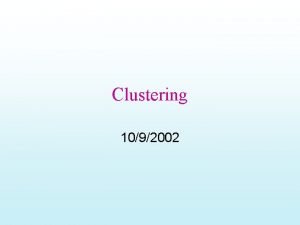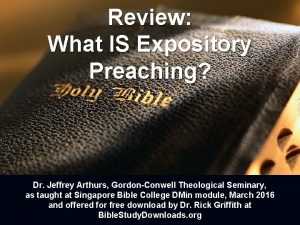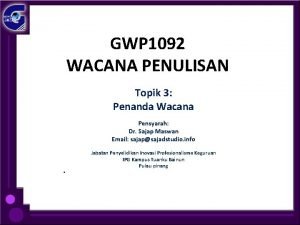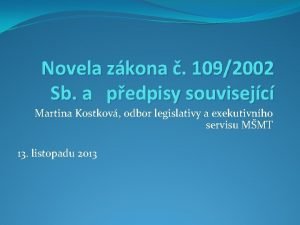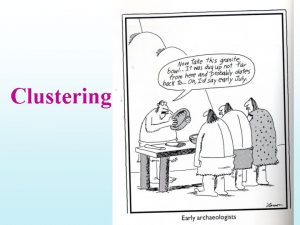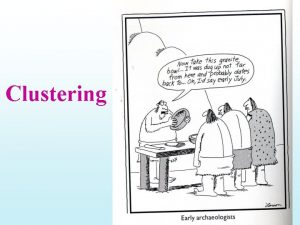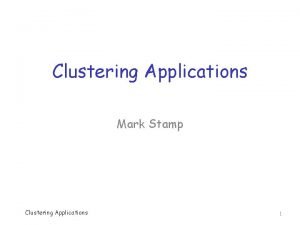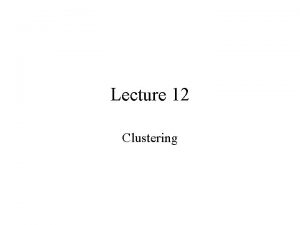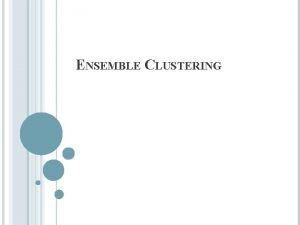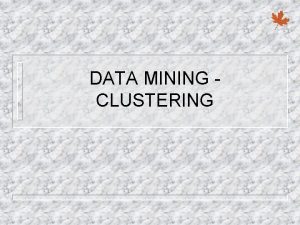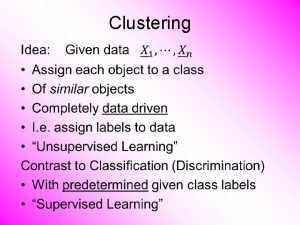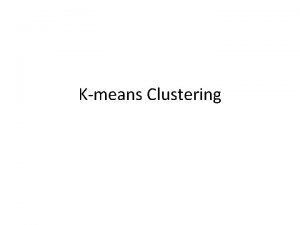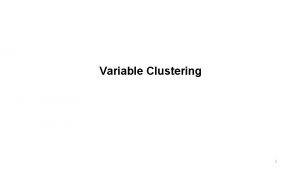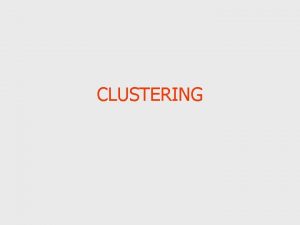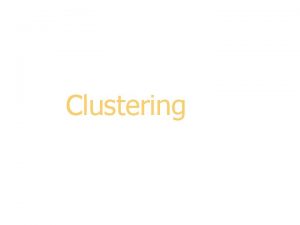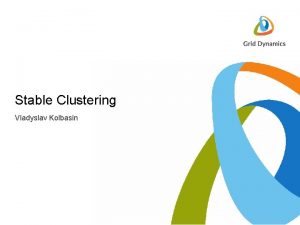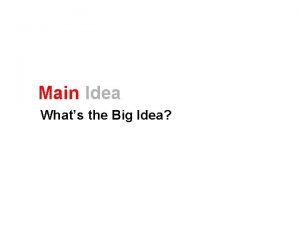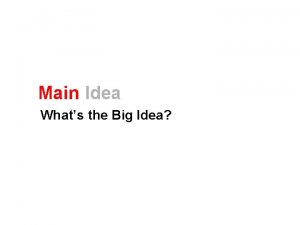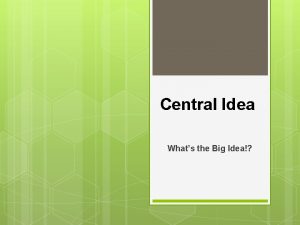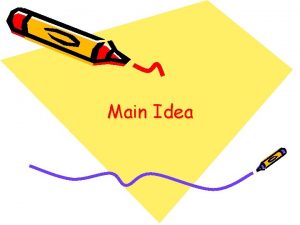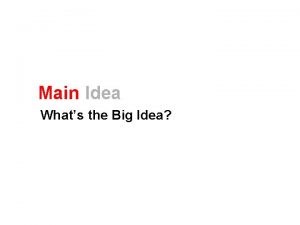Clustering 1092002 Idea and Applications Clustering is the












![Example of K-means in operation [From Hand et. Al. ] Example of K-means in operation [From Hand et. Al. ]](https://slidetodoc.com/presentation_image_h/fc79f51d1bb015b73ed080c5e68350f9/image-13.jpg)


















- Slides: 31

Clustering 10/9/2002

Idea and Applications • Clustering is the process of grouping a set of physical or abstract objects into classes of similar objects. – It is also called unsupervised learning. – It is a common and important task that finds many applications. • Applications in Search engines: – – Structuring search results Suggesting related pages Automatic directory construction/update Finding near identical/duplicate pages

When & From What • Clustering can be done at: – Indexing time – At query time • Applied to documents • Applied to snippets Clustering can be based on: URL source Put pages from the same server together Text Content -Polysemy (“bat”, “banks”) -Multiple aspects of a single topic Links -Look at the connected components in the link graph (A/H analysis can do it)


Concepts in Clustering – “Defining distance between points • Cosine distance (which you already know) • Overlap distance – A good clustering is one where • (Intra-cluster distance) the sum of distances between objects in the same cluster are minimized, • (Inter-cluster distance) while the distances between different clusters are maximized • Objective to minimize: F(Intra, Inter) – Clusters can be evaluated with “internal” as well as “external” measures • Internal measures are related to the inter/intra cluster distance • External measures are related to how representative are the current clusters to “true” classes – See entropy and F-measure in [Steinbach et. Al. ]

Inter/Intra Cluster Distances Intra-cluster distance • (Sum/Min/Max/Avg) the (absolute/squared) distance between - All pairs of points in the cluster OR - Between the centroid and all points in the cluster OR - Between the “medoid” and all points in the cluster Inter-cluster distance Sum the (squared) distance between all pairs of clusters Where distance between two clusters is defined as: - distance between their centroids/medoids - (Spherical clusters) - Distance between the closest pair of points belonging to the clusters - (Chain shaped clusters)

Lecture of 10/14

How hard is clustering? • One idea is to consider all possible clusterings, and pick the one that has best inter and intra cluster distance properties • Suppose we are given n points, and would like to cluster them into k-clusters – How many possible clusterings? • Too hard to do it brute force or optimally • Solution: Iterative optimization algorithms – Start with a clustering, iteratively improve it (eg. K-means)

Classical clustering methods • Partitioning methods – k-Means (and EM), k-Medoids • Hierarchical methods – agglomerative, divisive, BIRCH • Model-based clustering methods

K-means • Works when we know k, the number of clusters we want to find • Idea: – Randomly pick k points as the “centroids” of the k clusters – Loop: • For each point, put the point in the cluster to whose centroid it is closest • Recompute the cluster centroids • Repeat loop (until there is no change in clusters between two consecutive iterations. ) Iterative improvement of the objective function: Sum of the squared distance from each point to the centroid of its cluster

K-means Example • For simplicity, 1 -dimension objects and k=2. – Numerical difference is used as the distance • Objects: 1, 2, • K-means: 5, 6, 7 – Randomly select 5 and 6 as centroids; – => Two clusters {1, 2, 5} and {6, 7}; mean. C 1=8/3, mean. C 2=6. 5 – => {1, 2}, {5, 6, 7}; mean. C 1=1. 5, mean. C 2=6 – => no change. – Aggregate dissimilarity • (sum of squares of distanceeach point of each cluster from its cluster center--(intra-cluster distance) – = 0. 52+ 12+ 02+12 = 2. 5 |1 -1. 5|2

K Means Example (K=2) Pick seeds Reassign clusters Compute centroids Reasssign clusters x x Compute centroids Reassign clusters Converged! [From Mooney]
![Example of Kmeans in operation From Hand et Al Example of K-means in operation [From Hand et. Al. ]](https://slidetodoc.com/presentation_image_h/fc79f51d1bb015b73ed080c5e68350f9/image-13.jpg)
Example of K-means in operation [From Hand et. Al. ]

Time Complexity • Assume computing distance between two instances is O(m) where m is the dimensionality of the vectors. • Reassigning clusters: O(kn) distance computations, or O(knm). • Computing centroids: Each instance vector gets added once to some centroid: O(nm). • Assume these two steps are each done once for I iterations: O(Iknm). • Linear in all relevant factors, assuming a fixed number of iterations, – more efficient than O(n 2) HAC (to come next)

Problems with K-means • Need to know k in advance – Could try out several k? • Unfortunately, cluster tightness increases with increasing K. The best intra-cluster tightness occurs when k=n (every point in its own cluster) • Tends to go to local minima that are sensitive to the starting centroids – Try out multiple starting points • Disjoint and exhaustive – Doesn’t have a notion of “outliers” • Outlier problem can be handled by K -medoid or neighborhood-based algorithms • Assumes clusters are spherical in vector space – Sensitive to coordinate changes, weighting etc. Example showing sensitivity to seeds In the above, if you start with B and E as centroids you converge to {A, B, C} and {D, E, F} If you start with D and F you converge to {A, B, D, E} {C, F}

Variations on K-means • Recompute the centroid after every (or few) changes (rather than after all the points are Lowest aggregate Dissimilarity re-assigned) – Improves convergence speed (intra-cluster distance) • Starting centroids (seeds) change which local minima we converge to, as well as the rate of convergence – Use heuristics to pick good seeds • Can use another cheap clustering over random sample – Run K-means M times and pick the best clustering that results • Bisecting K-means takes this idea further…

1 d o eth m d i r Bisecting K-means b y H • For I=1 to k-1 do{ Can pick the largest Cluster or the cluster With lowest average similarity – Pick a leaf cluster C to split – For J=1 to ITER do{ • Use K-means to split C into two sub-clusters, C 1 and C 2 • Choose the best of the above splits and make it permanent} } Divisive hierarchical clustering method uses K-means

Class of 16 th October Midterm on October 23 rd. In class.

Hierarchical Clustering Techniques • Generate a nested (multiresolution) sequence of clusters • Two types of algorithms – Divisive • Start with one cluster and recursively subdivide • Bisecting K-means is an example! – Agglomerative (HAC) • Start with data points as single point clusters, and recursively merge the closest clusters “Dendogram”

Hierarchical Agglomerative Clustering Example • {Put every point in a cluster by itself. For I=1 to N-1 do{ let C 1 and C 2 be the most mergeable pair of clusters Create C 1, 2 as parent of C 1 and C 2} • Example: For simplicity, we still use 1 -dimensional objects. – Numerical difference is used as the distance • Objects: 1, 2, 5, 6, 7 • agglomerative clustering: – – find two closest objects and merge; => {1, 2}, so we have now {1. 5, 5, 6, 7}; => {1, 2}, {5, 6}, so {1. 5, 5. 5, 7}; => {1, 2}, {{5, 6}, 7}. 1 2 5 6 7

Single Link Example

Properties of HAC • Creates a complete binary tree (“Dendogram”) of clusters • Various ways to determine mergeability – “Single-link”—distance between closest neighbors – “Complete-link”—distance between farthest neighbors – “Group-average”—average distance between all pairs of neighbors – “Centroid distance”—distance between centroids is the most common measure • Deterministic (modulo tie-breaking) • Runs in O(N 2) time • People used to say this is better than Kmeans • But the Stenbach paper says K-means and bisecting Kmeans are actually better

Impact of cluster distance measures “Single-Link” (inter-cluster distance= distance between closest pair of points) [From Mooney] “Complete-Link” (inter-cluster distance= distance between farthest pair of points)

Complete Link Example

1 d o eth m d i r Bisecting K-means b y H • For I=1 to k-1 do{ Can pick the largest Cluster or the cluster With lowest average similarity – Pick a leaf cluster C to split – For J=1 to ITER do{ • Use K-means to split C into two sub-clusters, C 1 and C 2 • Choose the best of the above splits and make it permanent} } Divisive hierarchical clustering method uses K-means

2 d o eth yb m d i r H Buckshot Algorithm • Combines HAC and K-Means clustering. • First randomly take a sample of instances of size n • Run group-average HAC on this sample, which takes only O(n) time. • Use the results of HAC as initial seeds for K -means. • Overall algorithm is O(n) and avoids problems of bad seed selection. Uses HAC to bootstrap K-means Cut where You have k clusters

Text Clustering • HAC and K-Means have been applied to text in a straightforward way. • Typically use normalized, TF/IDF-weighted vectors and cosine similarity. • Optimize computations for sparse vectors. • Applications: – During retrieval, add other documents in the same cluster as the initial retrieved documents to improve recall. – Clustering of results of retrieval to present more organized results to the user (à la Northernlight folders). – Automated production of hierarchical taxonomies of documents for browsing purposes (à la Yahoo & DMOZ).

Which of these are the best for text? • Bisecting K-means and K-means seem to do better than Agglomerative Clustering techniques for Text document data [Steinbach et al] – “Better” is defined in terms of cluster quality • Quality measures: – Internal: Overall Similarity – External: Check how good the clusters are w. r. t. user defined notions of clusters

Challenges/Other Ideas • High dimensionality – Most vectors in high-D spaces will be orthogonal – Do LSI analysis first, project data into the most important m-dimensions, and then do clustering • E. g. Manjara • Phrase-analysis – Sharing of phrases may be more indicative of similarity than sharing of words • (For full WEB, phrasal analysis was too costly, so we went with vector similarity. But for top 100 results of a query, it is possible to do phrasal analysis) • Suffix-tree analysis • Shingle analysis • Using link-structure in clustering • A/H analysis based idea of connected components • Co-citation analysis • Sort of the idea used in Amazon’s collaborative filtering • Scalability – More important for “global” clustering – Can’t do more than one pass; limited memory – See the paper – Scalable techniques for clustering the web – Locality sensitive hashing is used to make similar documents collide to same buckets

Phrase-analysis based similarity (using suffix trees)

Other (general clustering) challenges • Dealing with noise (outliers) 1. “Neighborhood” methods • “An outlier is one that has less than d points within e distance” (d, e pre-specified thresholds) • Need efficient data structures for keeping track of neighborhood 1. R-trees • Dealing with different types of attributes – Hard to define distance over categorical attributes
 Color 1092002
Color 1092002 Flat and hierarchical clustering
Flat and hierarchical clustering Partitional clustering
Partitional clustering Rumus euclidean
Rumus euclidean Hierarchical clustering applications
Hierarchical clustering applications Is the central idea the same as the main idea
Is the central idea the same as the main idea What is controlling idea
What is controlling idea Is the main idea the theme
Is the main idea the theme Sentence for irrelevant
Sentence for irrelevant Stated main idea and implied main idea
Stated main idea and implied main idea Homiletical idea
Homiletical idea Penanda wacana mengapa
Penanda wacana mengapa Hát kết hợp bộ gõ cơ thể
Hát kết hợp bộ gõ cơ thể Slidetodoc
Slidetodoc Bổ thể
Bổ thể Tỉ lệ cơ thể trẻ em
Tỉ lệ cơ thể trẻ em Gấu đi như thế nào
Gấu đi như thế nào Tư thế worms-breton
Tư thế worms-breton Chúa yêu trần thế alleluia
Chúa yêu trần thế alleluia Môn thể thao bắt đầu bằng chữ f
Môn thể thao bắt đầu bằng chữ f Thế nào là hệ số cao nhất
Thế nào là hệ số cao nhất Các châu lục và đại dương trên thế giới
Các châu lục và đại dương trên thế giới Công thức tiính động năng
Công thức tiính động năng Trời xanh đây là của chúng ta thể thơ
Trời xanh đây là của chúng ta thể thơ Mật thư tọa độ 5x5
Mật thư tọa độ 5x5 Phép trừ bù
Phép trừ bù độ dài liên kết
độ dài liên kết Các châu lục và đại dương trên thế giới
Các châu lục và đại dương trên thế giới Thể thơ truyền thống
Thể thơ truyền thống Quá trình desamine hóa có thể tạo ra
Quá trình desamine hóa có thể tạo ra Một số thể thơ truyền thống
Một số thể thơ truyền thống Cái miệng nó xinh thế
Cái miệng nó xinh thế
